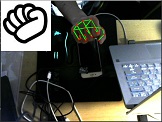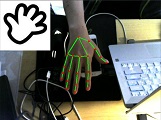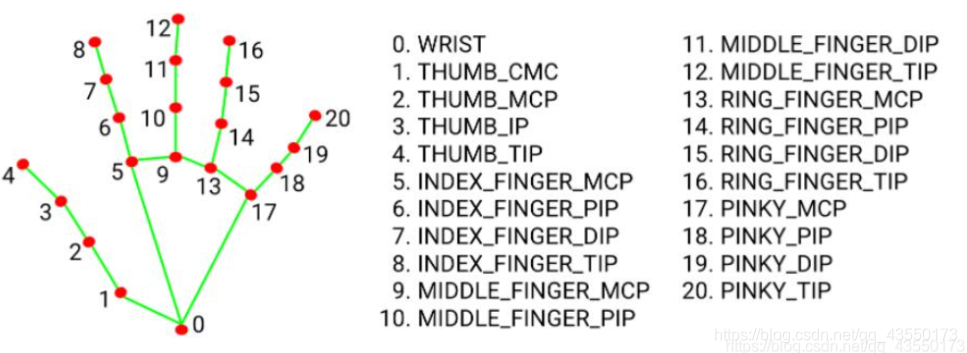环境:python3.8,pycharm2020
硬件:罗技c505e
基于前面一篇文章,我们已经能够实现手关键点的信息的提取,通过对这些信息的处理我们可以很轻松地进行手势识别。(完整代码见文末)
先看一波效果图:



封装函数(可跳过)
为方便调用,先将之前关键点提取相关函数分装成类
import cv2
import mediapipe as mp
import time
import math
class handDetctor():
def __init__(self, mode=False, maxHands=2, detectionCon=0.5, trackCon=0.5):
self.mode = mode
self.maxHands = maxHands
self.detectionCon = detectionCon
self.trackCon = trackCon
self.mpHands = mp.solutions.hands
self.hands = self.mpHands.Hands(self.mode, self.maxHands,
self.detectionCon, self.trackCon)
self.mpDraw = mp.solutions.drawing_utils
def findHands(self, img, draw=True, ):
imgRGB = cv2.cvtColor(img, cv2.COLOR_BGR2RGB)#转换为rgb
self.results = self.hands.process(imgRGB)
# print(results.multi_hand_landmarks)
if self.results.multi_hand_landmarks:
for handLms in self.results.multi_hand_landmarks:
if draw:
self.mpDraw.draw_landmarks(img, handLms, self.mpHands.HAND_CONNECTIONS)
return img
def findPosition(self, img, handNo=0, draw=True):
lmList = []
if self.results.multi_hand_landmarks:
myHand = self.results.multi_hand_landmarks[handNo]
for id, lm in enumerate(myHand.landmark):
# print(id, lm)
# 获取手指关节点
h, w, c = img.shape
cx, cy = int(lm.x*w), int(lm.y*h)
lmList.append([id, cx, cy])
if draw:
cv2.putText(img, str(int(id)), (cx+10, cy+10), cv2.FONT_HERSHEY_PLAIN,
1, (0, 0, 255), 2)
return lmList
# 调用方式
def main():
cap = cv2.VideoCapture(0, cv2.CAP_DSHOW)
# 帧率统计
pTime = 0
cTime = 0
detector = handDetctor()
while True:
success, img = cap.read()
img = detector.findHands(img)
lmList = detector.findPosition(img, draw=False)
if len(lmList) != 0:
print(lmList)
# 统计屏幕帧率
cTime = time.time()
fps = 1 / (cTime - pTime)
pTime = cTime
cv2.putText(img, str(int(fps)), (10, 70), cv2.FONT_HERSHEY_PLAIN, 3, (255, 0, 255), 3)
cv2.imshow("image", img)
if cv2.waitKey(2) & 0xFF == 27:
break
cap.release()
if __name__ == '__main__':
main()
手势判断
基于mediapipe我们已经能够获取手指关键点的坐标位置了,进一步只需要判断每根手指的开合状态即可得到手势。先贴以下关键点分布图:

下以判断食指的开合为例:
当食指伸直时,我们很容易发现8点到0点的距离明显比6点到0点的大
当食指缩回时,反之
判断每个手指:
def fingerStatus(self, lmList):
fingerList = []
id, originx, originy = lmList[0]
keypoint_list = [[2, 4], [6, 8], [10, 12], [14, 16], [18, 20]]
for point in keypoint_list:
id, x1, y1 = lmList[point[0]]
id, x2, y2 = lmList[point[1]]
if math.hypot(x2-originx, y2-originy) > math.hypot(x1-originx, y1-originy):
fingerList.append(True)
else:
fingerList.append(False)
return fingerList
调用:thumbOpen, firstOpen, secondOpen, thirdOpen, fourthOpen = detector.fingerStatus(lmList),需要注意的是要先获取21个标志点的坐标。
完整代码
HandTrackingModule.py
import cv2
import mediapipe as mp
import time
import math
class handDetctor():
def __init__(self, mode=False, maxHands=2, detectionCon=0.5, trackCon=0.5):
self.mode = mode
self.maxHands = maxHands
self.detectionCon = detectionCon
self.trackCon = trackCon
self.mpHands = mp.solutions.hands
self.hands = self.mpHands.Hands(self.mode, self.maxHands,
self.detectionCon, self.trackCon)
self.mpDraw = mp.solutions.drawing_utils
def findHands(self, img, draw=True, ):
imgRGB = cv2.cvtColor(img, cv2.COLOR_BGR2RGB)#转换为rgb
self.results = self.hands.process(imgRGB)
# print(results.multi_hand_landmarks)
if self.results.multi_hand_landmarks:
for handLms in self.results.multi_hand_landmarks:
if draw:
self.mpDraw.draw_landmarks(img, handLms, self.mpHands.HAND_CONNECTIONS)
return img
def findPosition(self, img, handNo=0, draw=True):
lmList = []
if self.results.multi_hand_landmarks:
myHand = self.results.multi_hand_landmarks[handNo]
for id, lm in enumerate(myHand.landmark):
# print(id, lm)
# 获取手指关节点
h, w, c = img.shape
cx, cy = int(lm.x*w), int(lm.y*h)
lmList.append([id, cx, cy])
if draw:
cv2.putText(img, str(int(id)), (cx+10, cy+10), cv2.FONT_HERSHEY_PLAIN,
1, (0, 0, 255), 2)
return lmList
# 返回列表 包含每个手指的开合状态
def fingerStatus(self, lmList):
fingerList = []
id, originx, originy = lmList[0]
keypoint_list = [[2, 4], [6, 8], [10, 12], [14, 16], [18, 20]]
for point in keypoint_list:
id, x1, y1 = lmList[point[0]]
id, x2, y2 = lmList[point[1]]
if math.hypot(x2-originx, y2-originy) > math.hypot(x1-originx, y1-originy):
fingerList.append(True)
else:
fingerList.append(False)
return fingerList
def main():
cap = cv2.VideoCapture(0, cv2.CAP_DSHOW)
# 帧率统计
pTime = 0
cTime = 0
detector = handDetctor()
while True:
success, img = cap.read()
img = detector.findHands(img)
lmList = detector.findPosition(img, draw=False)
if len(lmList) != 0:
# print(lmList)
print(detector.fingerStatus(lmList))
# 统计屏幕帧率
cTime = time.time()
fps = 1 / (cTime - pTime)
pTime = cTime
cv2.putText(img, str(int(fps)), (10, 70), cv2.FONT_HERSHEY_PLAIN, 3, (255, 0, 255), 3)
cv2.imshow("image", img)
if cv2.waitKey(2) & 0xFF == 27:
break
cap.release()
if __name__ == '__main__':
main()
gestureRecognition.py
import time
import cv2
import os
import HandTrackingModule as htm
wCam, hCam = 640, 480
cap = cv2.VideoCapture(0, cv2.CAP_DSHOW)
cap.set(3, wCam)
cap.set(4, hCam)
# 缓冲图像
picture_path = "gesture_picture"
myList = os.listdir(picture_path)
print(myList)
overlayList = []
for imPath in myList:
image = cv2.imread(f'{picture_path}/{imPath}')
overlayList.append(image)
detector = htm.handDetctor(detectionCon=0.7)
while True:
success, img = cap.read()
img = detector.findHands(img)
lmList = detector.findPosition(img, draw=False)
if len(lmList) != 0:
thumbOpen, firstOpen, secondOpen, thirdOpen, fourthOpen = detector.fingerStatus(lmList)
if not firstOpen and not secondOpen and not thirdOpen and not fourthOpen:
img[0:200, 0:200] = overlayList[1]
if firstOpen and secondOpen and not thirdOpen and not fourthOpen:
img[0:200, 0:200] = overlayList[0]
if firstOpen and secondOpen and thirdOpen and fourthOpen:
img[0:200, 0:200] = overlayList[2]
cv2.imshow("image", img)
if cv2.waitKey(2) & 0xFF == 27:
break
相关连接
https://gist.github.com/TheJLifeX/74958cc59db477a91837244ff598ef4a